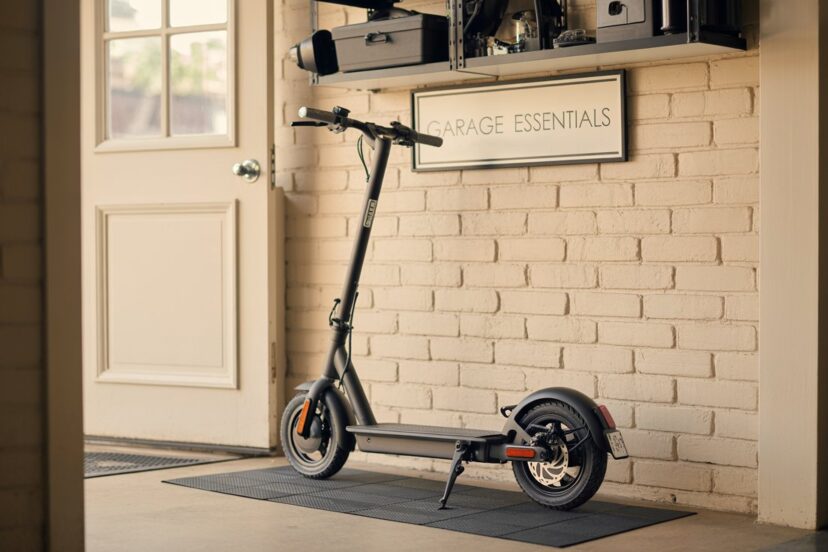How to Store an E-Scooter Properly to Extend Its Lifespan
*We may earn a commission for purchases made using our links. Please see our disclosure to learn more.
The gentle hum of an electric scooter gliding down the street has become a familiar soundtrack in cities worldwide. Yet behind every smooth ride lies a critical factor that many riders overlook: proper storage. The difference between an e-scooter that serves faithfully for years and one that fails prematurely often comes down to how it’s stored when not in use.
Weather extremes, improper positioning, and neglected maintenance can transform your reliable transportation companion into an expensive paperweight. Understanding the nuances of e-scooter storage isn’t just about finding a convenient spot to park – it’s about preserving the intricate balance of electronics, mechanics, and battery chemistry that keeps these modern marvels running.
Whether you’re dealing with scorching summer heat, freezing winter temperatures, or the everyday challenge of urban apartment living, the way you store your e-scooter directly impacts its performance, safety, and longevity. From battery degradation to frame corrosion, the consequences of poor storage practices compound over time, often revealing themselves when you need your scooter most.
“Proper storage is the single most important factor in extending an electric vehicle’s lifespan. It’s not just about convenience – it’s about protecting a significant investment.”
– Electric Vehicle Battery Research Institute
Key Takeaways
Before diving into the comprehensive storage strategies, here are the essential points every e-scooter owner should remember:
- Temperature control is critical – Store between 32°F and 77°F (0°C to 25°C) for optimal battery health
- Charge levels matter – Maintain 30-60% battery charge during long-term storage
- Moisture is the enemy – Always ensure your scooter is completely dry before storage
- Position affects longevity – Store upright or use proper hanging systems to prevent component stress
- Regular maintenance prevents problems – Monthly check-ups during storage periods prevent major issues
- Security considerations – Indoor storage significantly reduces theft risk and environmental damage
Recommended Storage Products
1. Portable E-Scooter Cover
Keep your ride safe and protected with the NiuJKun Electric Scooter Cover, a durable solution for riders who care about extending their scooter’s life. Made from high-quality Oxford fabric with a silver coating and double-stitched seams, this cover is waterproof, UV-resistant, and built to withstand rain, wind, and sun. Its reflective strips ensure nighttime visibility, while lock holes and a windproof buckle add extra security. Designed to fit most foldable e-scooters with or without seats, it comes with a handy storage bag for convenience. If you’re wondering how to store an e-scooter properly, this cover is an essential accessory.
- Protection: Shields against rain, UV rays, dust, and scratches for all-season use.
- Practical Design: Includes lock holes, reflective strips, and elastic edges for a secure fit.
- Easy Storage: Lightweight and foldable with a storage bag for portability.
- Fit Requirement: Measuring your scooter before purchase is necessary for the right size.
- Cleaning Restriction: Can’t be machine washed, only wipe-clean.
- Wind Resistance: May shift in extreme winds without proper adjustment.
If you want your scooter to last, it’s important to know how to store an e-scooter properly. Many riders overlook storage, leaving their scooters exposed to sunlight, rain, or dust, which can shorten their lifespan. The simplest and most effective solution is investing in a high-quality scooter cover like the NiuJKun Electric Scooter Cover.
2. Heavy-Duty Wall Mount Hook
Free up space and keep your scooter secure with the Peak Select Wall Mount Hook, designed specifically for Segway Ninebot ES1, ES2, and ES4 models. Made from durable, high-strength materials, this heavy-duty wall hanger provides reliable vertical storage without bending or warping. Its compact, minimalist design makes it perfect for apartments, garages, or entryways, helping you keep your scooter off the floor and neatly stored. If you’ve been searching for how to store an e-scooter efficiently, this wall mount is the smart solution for organized and safe storage.
- Space Efficiency: Keeps your scooter off the floor, saving room in small spaces.
- Durability: Built with strong materials to hold scooters securely.
- Easy Installation: Comes with screws and anchors for quick mounting.
- Compatibility: Designed mainly for Segway Ninebot ES1, ES2, and ES4 (limited for other models).
- Ground Contact Needed: Scooter should rest on the floor while mounted, not fully suspended.
- Single Purpose: Only functions as a storage rack, no extra features like charging integration.
One of the most effective ways to maximize space while protecting your ride is learning how to store an e-scooter properly. Scooters left on the floor are prone to scratches, accidental bumps, and clutter. That’s where the Peak Select Wall Mount Hook comes in. This wall hanger is specifically designed for Segway Ninebot ES1, ES2, and ES4 scooters, offering a secure and organized storage solution. Its strong build ensures your scooter stays in place, while the vertical design makes it easy to park and retrieve whenever you need it.
3. Dehumidifier Moisture Absorber
Keep your valuables dry and protected with the Vbeijll Color-Indicating Silica Gel Packets. Each 5-gram packet is made from safe, food-grade materials, making it suitable for use with food, medicine, electronics, and more. The premium orange indicator beads change color to dark green when fully saturated, letting you know when it’s time for reactivation. These packets can be easily recharged by heating in an oven, microwave, or even under sunlight, providing long-lasting moisture control.
- Reusable: Color-indicating beads allow easy monitoring and reactivation.
- Food Grade Safe: Non-toxic, tasteless, and safe for direct contact with food or medicine.
- Versatile Use: Works for food, electronics, tools, and storage of valuables.
- Heat Sensitivity: Packaging may melt if overheated during reactivation.
- Best in Airtight Spaces: Works less effectively in open environments.
- Small Size Limitation: May require multiple packs for larger storage areas.
When it comes to learning how to store an e-scooter, most riders think about covers and racks, but one overlooked factor is moisture. Humidity can damage batteries, corrode metal parts, and shorten the overall lifespan of your scooter. That’s why using silica gel desiccant packs is a smart step in proper e-scooter storage. The Vbeijll Color-Indicating Silica Gel Packets are a practical solution to control moisture in storage spaces. By placing a few packets inside your scooter’s storage bag, cover pocket, or nearby container, you can effectively prevent water vapor from affecting your scooter.
Understanding Your E-Scooter’s Storage Needs
Electric scooters represent a convergence of mechanical engineering and sophisticated electronics, making their storage requirements more complex than traditional kick scooters. The lithium-ion batteries that power these devices are particularly sensitive to environmental conditions, while the electronic components require protection from moisture and temperature extremes.
The frame materials – whether aluminum, steel, or carbon fiber – each respond differently to storage conditions. Aluminum frames resist corrosion but can suffer from galvanic corrosion when in contact with dissimilar metals in humid conditions. Steel frames require protection from rust, while carbon fiber components need protection from UV exposure and impact damage.
Understanding these material science principles helps explain why proper storage isn’t just about convenience – it’s about preserving the complex interplay of components that make modern e-scooters possible.
The Science of Battery Storage
Lithium-ion batteries operate through a delicate chemical balance that storage conditions directly affect. Temperature extremes accelerate chemical reactions within the battery cells, leading to capacity loss and shortened lifespan. Cold temperatures slow these reactions, potentially causing temporary capacity reduction, while heat speeds them up, causing permanent degradation.
The ideal storage charge level of 30-60% relates to the battery’s internal chemistry. Storing at full charge keeps the battery cells under stress, while completely depleted batteries can enter deep discharge states that damage the cells permanently. This “Goldilocks zone” of charge maintains cell stability while preventing the stress associated with extreme charge states.
Humidity affects batteries indirectly through its impact on electronic components and charging ports. Moisture can cause corrosion in connectors, leading to poor electrical connections and potential charging failures. Even small amounts of moisture can create problems over time, making complete drying essential before storage.
Indoor Storage Strategies
Indoor storage provides the most controlled environment for e-scooter preservation. Climate-controlled spaces maintain consistent temperature and humidity levels, protecting both battery chemistry and mechanical components from environmental stress.
When selecting indoor storage locations, avoid areas with high humidity such as basements without dehumidification or rooms adjacent to bathrooms. Similarly, avoid areas with significant temperature fluctuations like attics or rooms with poor insulation. The ideal indoor storage location maintains year-round temperatures between 60-70°F with relative humidity below 50%.
Positioning within indoor spaces matters significantly. Store scooters away from windows where direct sunlight can cause UV damage to plastic components and create localized heating. Avoid storage near heating vents, radiators, or other heat sources that can create temperature extremes.
Consider the flooring when selecting indoor storage spots. Concrete floors can transfer cold temperatures to the scooter and may retain moisture. Placing a rubber mat or wooden platform under the scooter creates insulation and moisture protection.
Outdoor Storage Considerations
While indoor storage is ideal, many riders must resort to outdoor storage due to space constraints or living situations. Outdoor storage requires additional protective measures to combat weather, temperature fluctuations, and security concerns.
Weather protection becomes paramount in outdoor storage scenarios. Even covered outdoor areas expose scooters to humidity fluctuations, temperature swings, and potential moisture infiltration. Quality protective covers designed specifically for e-scooters provide the first line of defense against these elements.
Wind considerations often get overlooked in outdoor storage planning. Strong winds can knock over improperly secured scooters, causing damage to handlebars, displays, or other protruding components. Securing the scooter to fixed objects or using weighted bases prevents wind-related damage.
Temperature management in outdoor storage requires understanding local climate patterns. In hot climates, seek shaded areas and consider reflective covers to minimize heat absorption. In cold climates, protect against freezing temperatures that can damage battery chemistry and cause expansion-related damage to components.
Seasonal Storage Protocols
Different seasons present unique storage challenges that require adapted strategies. Spring storage often involves dealing with high humidity from melting snow and increased rainfall. Ensure storage areas have adequate ventilation to prevent moisture buildup, and consider using moisture-absorbing products in enclosed storage spaces.
Summer storage must address heat management and UV protection. Even indoor storage areas can experience temperature spikes during heat waves. Monitor storage area temperatures and consider relocating scooters during extreme weather events. UV protection becomes critical for any outdoor storage, as prolonged exposure degrades plastic components and fades colors.
Fall storage preparation involves protecting against increased moisture from rain and falling leaves. Organic debris can retain moisture and promote corrosion when left in contact with metal components. Regular cleaning and inspection become more important during fall months.
Winter storage presents the greatest challenges in most climates. Freezing temperatures can permanently damage batteries, while road salt and de-icing chemicals create corrosive environments. If outdoor winter storage is unavoidable, frequent cleaning and additional protective measures become essential.
Battery Maintenance During Storage
Battery maintenance during storage periods requires balancing preservation with readiness. The 30-60% charge level mentioned earlier should be checked monthly, as batteries naturally discharge over time. However, avoid the temptation to fully charge before each storage period, as this can stress the battery chemistry.
Temperature monitoring becomes crucial for battery health during extended storage periods. Consider using wireless temperature sensors in storage areas to track conditions remotely. If temperatures exceed safe ranges, relocate the scooter or adjust storage conditions accordingly.
Charging port maintenance during storage prevents corrosion and ensures reliable connections when returning to use. Keep ports clean and dry, and consider using port covers or protective plugs to prevent debris accumulation.
Battery calibration after extended storage helps restore accurate charge level readings. This involves fully charging the battery, then discharging it completely before charging again. However, perform this calibration sparingly, as deep discharge cycles can stress battery chemistry.
Security and Theft Prevention
Storage location selection significantly impacts theft risk. Ground-level outdoor storage presents the highest risk, while indoor storage provides maximum security. When outdoor storage is necessary, choose well-lit, visible areas with high foot traffic to deter thieves.
Physical security measures during storage include locks, chains, and anchoring systems. However, remember that determined thieves can defeat most portable security measures. The goal is deterrence and slowing theft attempts to increase detection likelihood.
Consider the scooter’s value when selecting security measures. High-end scooters justify more expensive security systems, while basic models may not warrant significant security investments. Insurance considerations also factor into security planning, as some policies require specific security measures for coverage.
Documentation for insurance and recovery purposes should include serial numbers, photos, and purchase receipts stored separately from the scooter. This information proves invaluable if theft occurs and aids in insurance claims or police reports.
Maintenance Schedules for Stored Scooters
Monthly inspection routines during storage periods catch problems before they become serious. Check for signs of moisture infiltration, pest activity, or component degradation. Look for rust spots, corrosion, or unusual wear patterns that might indicate storage problems.
Tire maintenance during storage prevents flat spots and maintains proper inflation. Check tire pressure monthly and inflate to manufacturer specifications. For extended storage periods, consider slightly over-inflating tires to compensate for natural pressure loss.
Moving parts require periodic operation during storage to prevent seizure and maintain lubrication distribution. Monthly operation of brakes, throttles, and folding mechanisms keeps these components functional and identifies potential problems early.
Cleaning schedules during storage should address accumulated dust and debris. Even indoor-stored scooters collect dust that can interfere with moving parts and electronic connections. Gentle cleaning with appropriate products maintains appearance and functionality.
Common Storage Mistakes
Overlooking humidity control ranks among the most common storage mistakes. Many riders focus on temperature while ignoring moisture, leading to corrosion and electronic damage over time. Humidity affects all scooter components, making it equally important as temperature control.
Improper positioning during storage stresses components unnecessarily. Storing scooters on their sides or in twisted positions can damage cables, stress joints, and cause alignment problems. Always store in natural, supported positions that mirror normal use orientation.
Neglecting battery charge management during storage leads to premature battery failure. Both overcharging and deep discharge damage battery chemistry, yet many riders ignore batteries during storage periods. Regular monitoring prevents expensive battery replacements.
Using inappropriate storage locations exposes scooters to unnecessary risks. Storing near chemicals, in areas with pest problems, or in locations with security vulnerabilities creates avoidable problems. Choose storage locations as carefully as you would for valuable electronics.
Preparing for Return to Service
Pre-ride inspections after storage periods ensure safety and identify any problems that developed during storage. Check all safety systems, including brakes, lights, and steering mechanisms. Verify that folding mechanisms operate properly and lock securely.
Battery reactivation after storage requires patience and proper procedures. Allow batteries to reach room temperature before charging, and perform initial charges at reduced rates when possible. Monitor charging carefully for signs of problems like excessive heat or unusual charging times.
Mechanical system checks after storage should include tire pressure, brake adjustment, and hardware tightness. Storage can cause settling and loosening that affects performance and safety. Address these issues before returning to regular use.
Test rides after storage should start conservatively and gradually increase in complexity. Begin with low-speed operation in safe areas, testing all systems before returning to normal riding patterns. This staged approach identifies problems safely and builds confidence in the scooter’s reliability.
Conclusion
Proper e-scooter storage represents an investment in longevity, performance, and safety that pays dividends throughout the scooter’s lifespan. The strategies outlined here – from temperature and humidity control to security and maintenance protocols – work together to preserve the complex systems that make modern e-scooters possible.
The key lies in understanding that storage isn’t simply about finding a convenient parking spot, but about creating an environment that supports the scooter’s mechanical and electronic needs. Whether dealing with seasonal storage, space constraints, or security concerns, the principles remain consistent: control temperature and humidity, maintain proper charge levels, protect from physical damage, and monitor conditions regularly.
Every scooter owner faces unique storage challenges based on climate, living situation, and usage patterns. However, the fundamental principles of preservation apply universally. By adapting these strategies to individual circumstances, riders can maximize their investment while ensuring reliable transportation for years to come.
The effort invested in proper storage practices multiplies over time, preventing premature component failure, maintaining performance characteristics, and preserving the joy of effortless urban mobility that drew many to e-scooters initially.
Frequently Asked Questions
Q: How long can I store my e-scooter without using it?
With proper storage conditions and battery maintenance, most e-scooters can be stored safely for 3-6 months. Check battery charge monthly and maintain 30-60% charge levels. For longer storage periods, consider more frequent monitoring and potential battery cycling.
Q: Is it safe to store my e-scooter in a shed or garage during winter?
Yes, provided the space doesn’t freeze and maintains reasonable humidity levels. Unheated spaces that stay above 32°F work well, but avoid areas that experience freezing temperatures. Consider insulation or moving to heated spaces during extreme cold snaps.
Q: Should I remove the battery when storing my e-scooter long-term?
Only if the manufacturer specifically recommends it and the battery is easily removable. Most modern e-scooters are designed for integrated storage. Removing batteries can create connection problems and void warranties. Focus on proper charge levels and environmental conditions instead.
Q: What should I do if my scooter got wet before storage?
Never store a wet scooter. Thoroughly dry all surfaces, paying special attention to charging ports, display areas, and crevices where water might collect. Allow 24-48 hours of drying time in a warm, ventilated area before placing in storage.
Q: How often should I check on my stored e-scooter?
Monthly inspections work well for most storage situations. Check battery charge levels, look for signs of moisture or pest problems, and verify that security measures remain intact. More frequent checks may be necessary in challenging storage environments or during extreme weather periods.












